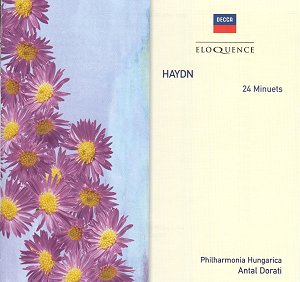This is a disc for
completists who have collected Dorati’s
cycles of Haydn symphonies and operas
and wish to supplement their collections.
Provided you tackle this disc over several
sessions and not straight through in
a single sitting there is pleasant listening
to be had. These readings are marvellously
alive; Papa Haydn in his best dancing
mood.
There is one other
competing version. It’s on CPO but I
have not heard it. This is played by
Capella Istropolitana, long a mainstay
of the various Naxos Baroque series.
The same orchestra have also been involved
in some very fine Haydn symphony recordings
under Barry Wordsworth, so their performances
should be well worth hearing. Those
collectors who are knowledgeable about
both projects will be able to predict
the differences between the two renditions.
I am going to go for
the current disc as a recommendation
since, although the Capella Istropolitana
are very good, they lack the sterling
experience of the Dorati/Philharmonia
Hungarica team. The other main difference
is that the Capella Istropolitana is
a chamber group whilst the Philharmonia
Hungarica is a full-sized symphony orchestra,
albeit sounding slightly smaller for
this recording.
Haydn was a great humourist
in music, and there is a very fine example
of this in the minuets. No. 19 has a
central section using percussion instruments.
This made me laugh out loud. There is
real entertainment to be had from this
life-enhancing music.
Most of Haydn’s dance
music was unknown until the 1930s when
some of the minuets were uncovered by
Otto Erich Deutsche and Ernst Fritz
Schmid and published for the Redoutensaal
in Vienna. The current set of 24 is
derived from a set of manuscripts sourced
from Haydn’s publishers Artaria &
Co. Aloys Fuchs listed these minuets
in his 1839 thematic catalogue where
their entry reads: ‘XXIV Menuetten f.
orchester Comp. In London 1791 – 1795’.
It is probable that these minuets were
produced after his London sojourns.
This conclusion is supported by the
orchestration, which features clarinets
and trumpets. The style is that of the
later masses. Haydn may well have produced
the minuets for a Grand Ball at Eisenstadt
in 1796 or 1797.
They are not like those
found in the symphonies. Here there
are no changes of tonality or other
complications. They are out-and-out
dance music written for pure pleasure.
The orchestra and the conductor take
on the task with utter and evident relish.
This is yet another
example of the Australian arm of Universal
picking out repertoire long unavailable
elsewhere and now accessible at a crazy
knock-down price; my last shipment came
to £3.75 per disc. Even adding air freight
costs these discs work out at just a
few pence over £6.00 each.
Recording, presentation
and notes are all first class and your
enjoyment is guaranteed. Very highly
recommended.
John Phillips
Footnote
I have noticed a wrong
indication regarding the geographical
location on the city of Marl, where
Antal Dorati recorded 25 minuets by
Joseph Haydn in September 1975. Marl
is not a town in Hungary, but a town
of the Ruhr region in Germany.
Among the refugees who fled Hungary
after the 1956 Soviet invasion were
hundreds of musicians. Eighty of them
formed an orchestra in Vienna and struggled
to get work. This refugee ensemble gathered
together some of Hungary's finest musical
talent and was directed by Zoltán
Rozsnyai, an ex-conductor of the Hungarian
National Philharmonic Orchestra. After
a difficult beginning in Vienna, the
wealthy industrial city of Marl in Germany
(a center of coal mining and chemical
industry) gave the orchestra a residency
from 1956 to 2001. Through the efforts
of Antal Doráti, the Philharmonia
Hungarica quickly matured into one of
Europe's most distinguished orchestras.
During the early 1970s, Dorati and the
orchestra, under contract with Decca
Records, made a canonical, world-first
recording of the complete cycle of Haydn's
symphonies. The reocrdings took place
in the local church of St Boniface.
At the final session, in December 1972,
Dorati announced that they had sold
half a million Haydn records.
I know that it´s only a small
detail, but it has to do with music
and recording history and it is better
to avoid mistakes in a specialized web-site.
Very friendly yours,
Jean-Luc Malvache.
